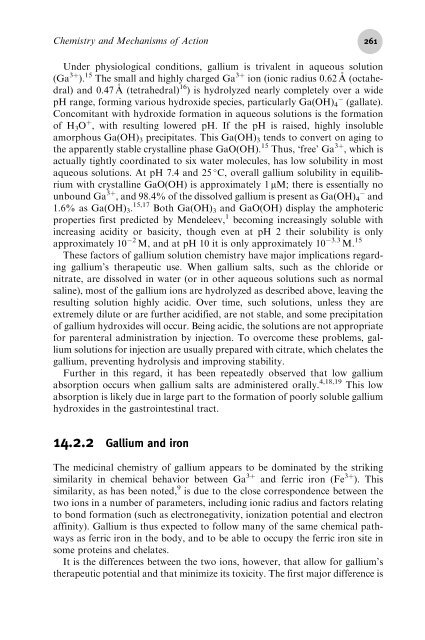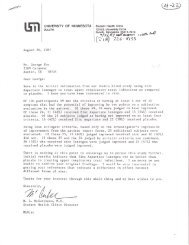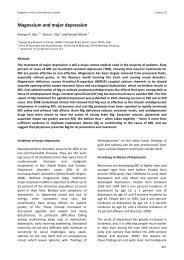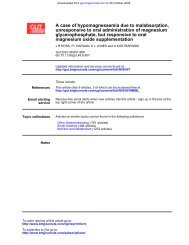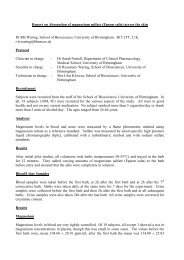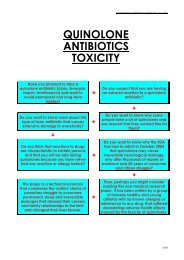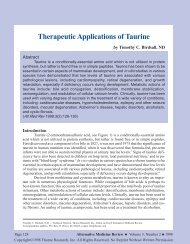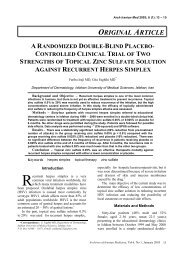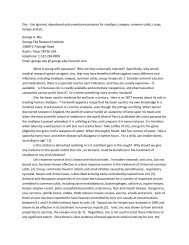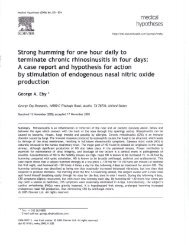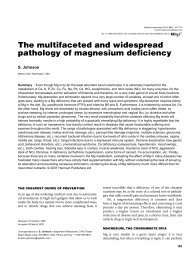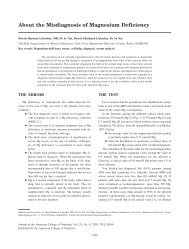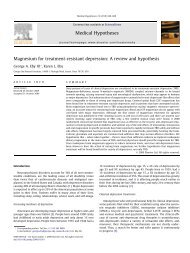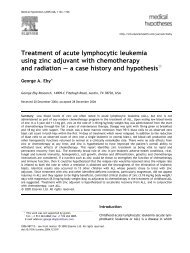Therapeutic Gallium Compounds - George Eby Research Institute
Therapeutic Gallium Compounds - George Eby Research Institute
Therapeutic Gallium Compounds - George Eby Research Institute
Create successful ePaper yourself
Turn your PDF publications into a flip-book with our unique Google optimized e-Paper software.
Chemistry and Mechanisms of Action 261<br />
Under physiological conditions, gallium is trivalent in aqueous solution<br />
(Ga 3þ ). 15 The small and highly charged Ga 3þ ion (ionic radius 0.62 A˚ (octahedral)<br />
and 0.47 A˚ (tetrahedral) 16 ) is hydrolyzed nearly completely over a wide<br />
pH range, forming various hydroxide species, particularly Ga(OH) 4 (gallate).<br />
Concomitant with hydroxide formation in aqueous solutions is the formation<br />
of H 3 O þ , with resulting lowered pH. If the pH is raised, highly insoluble<br />
amorphous Ga(OH) 3 precipitates. This Ga(OH) 3 tends to convert on aging to<br />
the apparently stable crystalline phase GaO(OH). 15 Thus, ‘free’ Ga 3þ , which is<br />
actually tightly coordinated to six water molecules, has low solubility in most<br />
aqueous solutions. At pH 7.4 and 25 C, overall gallium solubility in equilibrium<br />
with crystalline GaO(OH) is approximately 1 mM; there is essentially no<br />
unbound Ga 3þ , and 98.4% of the dissolved gallium is present as Ga(OH) 4 and<br />
1.6% as Ga(OH) 3 . 15,17 Both Ga(OH) 3 and GaO(OH) display the amphoteric<br />
properties first predicted by Mendeleev, 1 becoming increasingly soluble with<br />
increasing acidity or basicity, though even at pH 2 their solubility is only<br />
approximately 10 2 M, and at pH 10 it is only approximately 10 3.3 M. 15<br />
These factors of gallium solution chemistry have major implications regarding<br />
gallium’s therapeutic use. When gallium salts, such as the chloride or<br />
nitrate, are dissolved in water (or in other aqueous solutions such as normal<br />
saline), most of the gallium ions are hydrolyzed as described above, leaving the<br />
resulting solution highly acidic. Over time, such solutions, unless they are<br />
extremely dilute or are further acidified, are not stable, and some precipitation<br />
of gallium hydroxides will occur. Being acidic, the solutions are not appropriate<br />
for parenteral administration by injection. To overcome these problems, gallium<br />
solutions for injection are usually prepared with citrate, which chelates the<br />
gallium, preventing hydrolysis and improving stability.<br />
Further in this regard, it has been repeatedly observed that low gallium<br />
absorption occurs when gallium salts are administered orally. 4,18,19 This low<br />
absorption is likely due in large part to the formation of poorly soluble gallium<br />
hydroxides in the gastrointestinal tract.<br />
14.2.2 <strong>Gallium</strong> and iron<br />
The medicinal chemistry of gallium appears to be dominated by the striking<br />
similarity in chemical behavior between Ga 3þ and ferric iron (Fe 3þ ). This<br />
similarity, as has been noted, 9 is due to the close correspondence between the<br />
two ions in a number of parameters, including ionic radius and factors relating<br />
to bond formation (such as electronegativity, ionization potential and electron<br />
affinity). <strong>Gallium</strong> is thus expected to follow many of the same chemical pathways<br />
as ferric iron in the body, and to be able to occupy the ferric iron site in<br />
some proteins and chelates.<br />
It is the differences between the two ions, however, that allow for gallium’s<br />
therapeutic potential and that minimize its toxicity. The first major difference is


